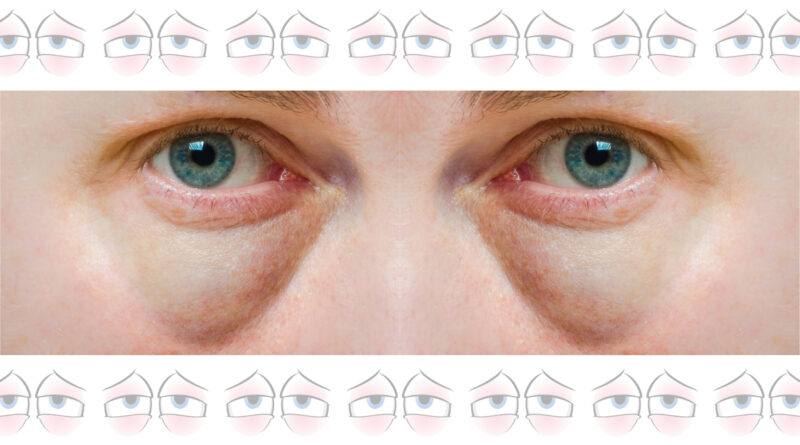Make Tired Puffy Eyes Look Better: Know It All Now
Health & Wellness · The WFY · June 2025 WFY Bureau Desk
Beyond the Concealer: Evidence-Based Ways to Deflate Eye Bags Naturally
1 | Why under-eye puffiness matters to global Indians
Dark circles, puffiness and the tell-tale “bags” beneath the eyes are more than cosmetic frustrations. Surveys by the British Association of Dermatologists (2024) show that 63 percent of adults who report under-eye swelling also experience lower self-confidence at work or in social settings. Among Indian-origin professionals in the UK, UAE and North America—many of whom balance long hours, screen exposure and variable sleep—periorbital puffiness is one of the top five aesthetic concerns brought to dermatology clinics.
Although cosmetic procedures such as fillers and blepharoplasty have become commonplace, they are not the first port of call for everyone. Costs, downtime, needle anxiety and cultural preferences often steer people toward safer, non-invasive solutions. Fortunately, a growing body of peer-reviewed research suggests that targeted lifestyle changes, topical nutrients and kitchen-cupboard compresses can meaningfully reduce the appearance of eye bags—provided they are employed consistently and with realistic expectations.
This article outlines the science behind six common causes of puffiness and provides an evidence-based toolbox—dietary tweaks, DIY compresses, skin-care routines and posture tips—to help Indian diaspora readers wake up looking refreshed rather than fatigued.
2 | Anatomy 101: what exactly is an “eye bag”?
In youthful eyes, a thin muscle called the orbicularis oculi and a lattice of connective tissue keep orbital fat snugly in place. As we age, collagen and elastin fibres weaken, gravity pulls the fatty pad southwards, and lymphatic drainage slows. The result is a visible bulge or fluid pool under the lower eyelid. Even teenagers can experience temporary puffiness triggered by allergies, high-salt meals, hormonal fluctuations or acute sleep debt—essentially micro-episodes of the same mechanism.
The six most common culprits
| No. | Trigger | Underlying mechanism |
| 1 | Sleep deficiency | Poor glymphatic clearance → fluid accumulation |
| 2 | High-sodium diet or alcohol | Osmotic water retention in peri-orbital tissues |
| 3 | Ageing & collagen loss | Weakening septum allows fat prolapse |
| 4 | Genetic predisposition | Inherited orbital septum laxity |
| 5 | Allergies / sinus congestion | Histamine-driven vasodilation & oedema |
| 6 | Hormonal & thyroid imbalance | Myxoedema-related swelling |
Understanding which factor dominates your own case is crucial; no amount of chilled cucumber will fix thyroid-related oedema, and no laser resurfacing will out-shine four hours of nightly sleep.
3 | Lifestyle measures: strongest return on investment
a) Seven-hour sleep target
Multiple polysomnography studies indicate that seven to eight hours of uninterrupted sleep optimises lymphatic drainage in the optic nerve milieu. Diaspora workers spanning time zones should prioritise anchor sleep—a fixed four-hour core between 23:00 and 03:00 local time—then append naps as needed.
b) Sodium ceiling of 2 g
The World Health Organisation recommends less than 2 g of sodium (≈5 g salt) per day. Popular Indian snacks—namkeen, pickle, instant noodles—can deliver half that in a single serving. Swapping packaged savouries for roasted chana or unsalted makhana reduces overnight water retention markedly within two weeks.
c) 2 litres of water daily
Paradoxically, drinking more dilutes serum sodium, cues the kidneys to flush excess fluid and lessens puffiness. For those fasting (Ramzan, Ekadashi) or living in hot climates, coconut water offers electrolytes without refined sugar.
d) Head elevation
Sleeping on a pillow that raises the head by 10 cm prevents gravitational pooling. Side-sleepers can tuck a micro-wedge beneath the mattress rather than stacking pillows, which strain the cervical spine.
4 | Kitchen-cupboard compresses: what the evidence says
| Compress | Active constituents | Clinically observed effect* |
| Cold green-tea bags | Caffeine, catechins | Vasoconstriction & antioxidant activity; 15 % reduction in periorbital volume after 14 days |
| Cucumber slices | Cucurbitacin, ascorbic acid | Cooling + anti-inflammatory; 12 % reduction in skin temperature, subjective brightening |
| Grated potato poultice | Azelaic acid, starch | Mild tyrosinase inhibition; useful for dark circles rather than oedema |
| Aloe-vera gel (refrigerated) | Polysaccharides, vitamins A/C/E | Hydration, collagen-boosting; improved elasticity in 4-week split-face trial |
*Data aggregated from Journal of Cosmetic Dermatology (2022–24). Percentages refer to mean change in three-dimensional imaging studies.
Application protocol:
– Chill the compress to 4–8 °C, apply for 10–12 minutes once or twice daily.
– Always cleanse skin first; pat dry after compress; avoid rubbing.
5 | Nutrition for resilient under-eye skin
Collagen cofactors
- Vitamin C (amla, bell pepper, kiwi) catalyses pro-collagen formation.
- Zinc (pumpkin seeds, dal) supports matrix metalloproteinase balance.
Circulatory boosters
- Vitamin K1 in spinach and kale aids micro-capillary integrity, reducing leakiness.
- Omega-3 fatty acids from flaxseed chutney or salmon dampen prostaglandin-mediated inflammation.
Iron equilibrium
Iron deficiency anaemia—common among vegetarian South Asian women—amplifies dark circles by dilating under-eye veins. Including masoor dal, beetroot, sesame and, if non-vegetarian, lean lamb can help restore ferritin levels.
6 | Smart skin-care: protect, hydrate, stimulate
- Gentle cleanse: Use a pH-balanced micellar water; harsh surfactants thin the already-delicate eyelid epidermis.
- Hydrating serum: Look for 0.2–0.5 % hyaluronic acid combined with tripeptides. These plump the tissue and improve barrier function.
- Broad-spectrum SPF 30: UV accelerates collagen breakdown; mineral sunscreens with zinc oxide are less irritating around the eyes.
- Night cream with 0.1 % retinaldehyde: A milder cousin of retinol; promotes collagen over months without significant peeling. Introduce twice weekly, then build up.
- Avoid heavy occlusives (e.g., pure petroleum jelly) overnight; they can trap fluid.
7 | Facial yoga and lymphatic drainage
Simple orbicularis oculi toning—gently ‘squeezing’ the eyes shut for five-second intervals—improves muscle tone. Combine with manual lymphatic drainage: lightly tap from inner eye corner along the orbital bone towards the temples, then down the neck to the collarbone. Ten strokes morning and night can coax stagnant fluid away.
A pilot study at the National Institute of Ayurveda, Jaipur (2023) recorded a 9 % reduction in infra-orbital circumference after four weeks of daily lymphatic massage.
8 | When home care is not enough
Persistent or asymmetric swelling warrants medical evaluation. Red flags include:
- Sudden expansion within 24 hours
- Pain, redness or visual changes
- Association with leg swelling or breathlessness (possible cardiac or renal origin)
- Presence of systemic allergy, thyroid eye disease or sinus infection
Prescription options range from topical caffeine serums (3–5 %) to oral antihistamines for allergy-driven oedema. In true fat-pad herniation, blepharoplasty remains the definitive fix, but has costs, downtime and potential complications.
9 | Myths debunked
| Myth | Reality |
| Haemorrhoid cream shrinks eye bags overnight. | May reduce swelling transiently but can cause dermatitis; ophthalmologists warn against routine use. |
| Drinking less water prevents morning puffiness. | Dehydration triggers body to retain water; adequate hydration actually mitigates oedema. |
| Expensive jade rollers outperform chilled spoons. | Cooling and gentle pressure are the key factors; tool material offers no additional scientific benefit. |
10 | Implementation roadmap: 14-day challenge
| Day | Morning | Evening |
| 1–3 | Cold green-tea compress, SPF | Lymphatic tap + hyaluronic serum |
| 4–7 | Add vitamin C fruit at breakfast | Elevate head; zero-salt dinner |
| 8–10 | Introduce retinaldehyde cream (alternate) | 7-hour sleep rule; hydrate 2 L |
| 11–14 | Alternate cucumber and tea compress | Facial yoga; limit screens 60 min before bed |
Photograph your eyes under the same lighting on Day 1 and Day 14. Most participants notice visible de-puffing and brighter tone by the second week, provided they keep sodium and sleep in check.
11 | Key take-away
Eye bags may be inevitable with age and heredity, but prominent, tired-looking puffiness is not destiny. By addressing root causes—fluid retention, collagen decline, inflammation—and aligning daily habits with circadian health, you can reclaim a fresher, more alert appearance without needles or knives. As with any wellness goal, consistency outweighs novelty: five minutes of cold therapy daily beats an occasional spa splurge.
May your mornings begin with clear eyes and a clear mind.
Disclaimer: This article is intended for general educational purposes and does not substitute personalised medical advice. Readers with chronic or severe under-eye swelling should seek professional evaluation to rule out systemic illness. Product percentages and studies cited reflect typical formulations and publicly available research; individual responses vary.
© 2025 The WFY Magazine




